Learn through the super-clean Baeldung Pro experience:
>> Membership and Baeldung Pro.
No ads, dark-mode and 6 months free of IntelliJ Idea Ultimate to start with.
Last updated: March 18, 2024
In this tutorial, we’ll learn about different algorithms to generate all -element subsets of a set containing
elements. This problem is referred to as
-combinations.
The mathematical solution to find the number of -combinations is straightforward. It’s equal to the binomial coefficient:
For example, let’s assume we have a set containing 6 elements, and we want to generate 3-element subsets. In this case, there are 6 ways that we can choose the first element. Then, we choose the second element from the remaining 5. Finally, we choose the third and last element of the subset from the remaining 4. The number of choices we’ve had so far is exactly .
Since the ordering of our choices doesn’t matter as we’re constructing a subset, we need to divide by . Hence we reach the same formula:
However, generating all such subsets and enumerating them is more complicated than merely counting them. Let’s have a look at different algorithms that create the subsets in different ways in the following sections.
The algorithms we’ll review in the following sections were initially compiled in “The Art of Computer Programming” by computer scientist Donald Knuth.
Lexicographic order is an intuitive and convenient way to generate -combinations.
The algorithm assumes that we have a set containing
elements: {0, 1, … ,
}. Then, we generate the subsets containing
elements in the form
, starting from the smallest lexicographic order:

The algorithm visits all -combinations. It recursively represents multiple nested for loops. For example, when
=3, it’s equivalent to 3 nested for loops to generate combinations of length 3:
algorithm visitCombinations(n):
// INPUT
// n = The upper limit for generating combinations
// OUTPUT
// Visits all unique combinations of three different numbers
// that are not higher than n.
for c3 in 2 to n - 1:
for c2 in 1 to c3 - 1:
for c1 in 0 to c2 - 1:
// Visit the combination c3, c2, c1
visitCombination(c3, c2, c1)In each iteration of the lexicographic generation algorithm, we find the smallest value, i.e., the rightmost element
, that we can increment. Then we set the subsequent elements
to their smallest values.
For instance, when we have = 6 and
= 3, the algorithm generates the lexicographically ordered sequence:
| 210 | 420 | 510 | 532 |
| 310 | 421 | 520 | 540 |
| 320 | 430 | 521 | 541 |
| 321 | 431 | 530 | 542 |
| 410 | 432 | 531 | 543 |
We can formulate the -combinations as a Knapsack problem. Subsequently, an optimal solution involves visiting nodes in a binomial tree.
Binomial Trees is a tree family used in combination generation. They are denoted by for
, such that:

For example, contains a root and subtrees
:
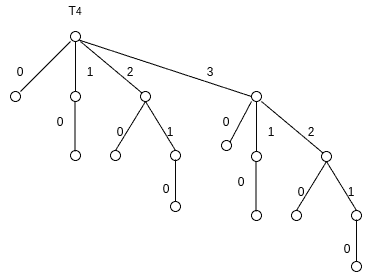
It’s easy to see that can be iteratively constructed from
by inserting another copy of
. So,
contains
nodes. Moreover, the number of nodes at each level
equals to
in
for
in {0,…,
-1}. In this sense, the variations of Lexicographic generation algorithm traverses the nodes of
on level
.
Let’s recall the 0-1 Knapsack Problem, where we either take or don’t take any element from a set of size to fill a rucksack. We can formulate our problem in a similar fashion, where we have a rucksack of size
and we want to find all subset combinations of elements of set S. Let’s set
for
. Subsets with number of elements
in the form
are valid solutions to this problem.
In this case, every possible solution corresponds to a node of . We can use the following algorithm to visit each valid node in preorder:
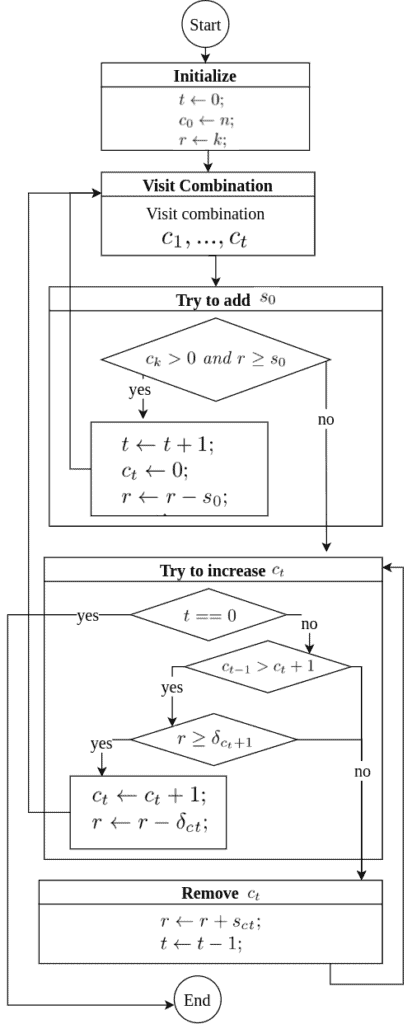
The algorithm only visits valid nodes of , skipping non-valid nodes. After the initialization phase, we visit the combination
, using up
space out of
. Then we try to add elements to the combination at hand without exceeding the space restriction. If an element
fits into a rucksack, we place it in after exhausting all possibilities using
in its place.
Another way to represent the -combinations problem is using Gray codes.
Imagine a revolving door connecting two rooms. There are people in the left room and
people on the right one. Hence, we have
people in total. In this setting, we let a person go into the other room only by switching with somebody else, so that the number of people in the rooms never change:
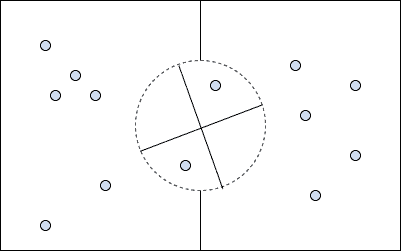
To represent the people in the rooms, we utilize bit binary strings. 0’s represent the people in the left room, and 1’s represent the people in the other room. Hence, 2 bits of a combination string bits are flipped when two people use the revolving door to switch places.
Let’s construct an algorithm to generate a sequence of combinations that don’t repeat. To generate such a sequence, we adopt Gray codes. We’ll enumerate orderings, where two successive representations always differ by one binary bit. Then, we’ll select only the binary representations containing zeroes and
ones amongst them. Hence, the code sequence will satisfy the revolving door constraint.
By definition, we generate Gray binary codes of lenght recursively. Let
represent a binary code of length
. We canformulate it more formally as:
In other words, we generate Gray codes of length by inserting a leading 0 or 1 to Gray codes of length
-1.
As our set has elements, we formulate a combination with a bit string of length
. This string represents which elements to include in the combination with a 1, and not to include with a 0. To ensure we generate only the codes valid for the
-combinations problem, we need to generate codes containing
zeros and
ones:
For instance, let’s consider the case =6 and
=3. Let’s generate
:
| 000111 | 011010 | 110001 | 101010 |
| 001101 | 011100 | 110010 | 101100 |
| 001110 | 010101 | 110100 | 100101 |
| 001011 | 010110 | 111000 | 100110 |
| 011001 | 010011 | 101001 | 100011 |
Converting the bit strings to combinations , we see a clear pattern:
| 210 | 431 | 540 | 531 |
| 320 | 432 | 541 | 532 |
| 321 | 420 | 542 | 520 |
| 310 | 421 | 543 | 521 |
| 430 | 410 | 530 | 510 |
In this sequence, occurs in increasing order. But for fixed values of
,
appears in increasing order. Moreover, for fixed
combinations,
values are increasing again. So, we can say that the characters of combination alternatingly increase and decrease.
Putting it all together, we construct the revolving door algorithm to visit -combinations:
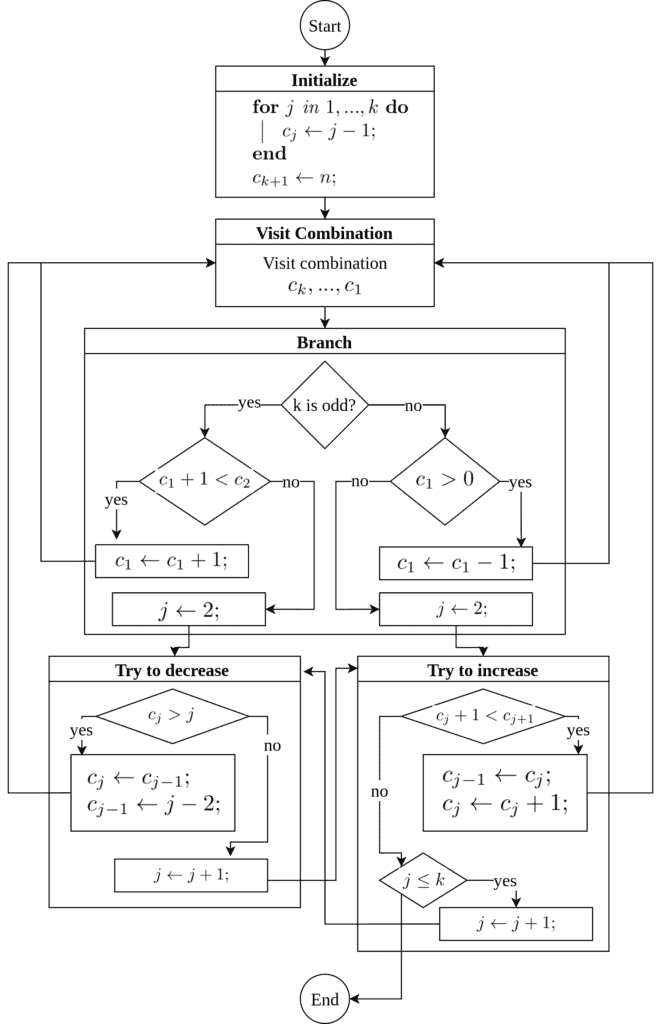
We call a Gray path sequence homogeneous if only one is changed at each step. Since we have multiple indices changing simultaneously, the revolving door algorithm does not generate a homogeneous sequence. For instance, the transition from 210 to 320 or 432 to 420 doesn’t obey the homogeneity rule.
We can generate a homogenous Gray sequence for =6 and
=3:
| 000111 | 010101 | 101100 | 100011 |
| 001011 | 010011 | 101001 | 110001 |
| 001101 | 011001 | 101010 | 110010 |
| 001110 | 011010 | 100110 | 110100 |
| 010110 | 011100 | 100101 | 111000 |
This bitstring corresponds to a homogenous sequence:
| 210 | 420 | 532 | 510 |
| 310 | 410 | 530 | 540 |
| 320 | 430 | 531 | 541 |
| 321 | 431 | 521 | 542 |
| 421 | 432 | 520 | 542 |
Even better, we can generate all -combinations by strongly homogenous transitions. In such a sequence, the
index moves by at most 2 steps. These generation schemes are called near-perfect.
Chase formulated an easy to compute version of nearly-perfect sequences. Again, let’s say we have elements, and we want to find
-combinations. Hence, we generate the binary sequence containing
ones and
zeros recursively:
As a result, we can use this algorithm to generate a sequence visiting all -combinations in near-perfect order. It’s called Chase’s sequence. There are exactly 2
such combinations.
Deducing from near-perfect combinations, we wonder if it’s possible to generate -combination sequences by only switching adjacent bits. This form is called a perfect scheme. Mathematicians proved that finding a perfect combination is possible only if
or
or
is odd. In short, finding a perfect scheme is possible in only 1 in 4 cases.
In summary, the -combinations generation problem constructs elegant patterns. Heatmaps built with the binary outputs of the discussed strategies make these patterns easier to follow:
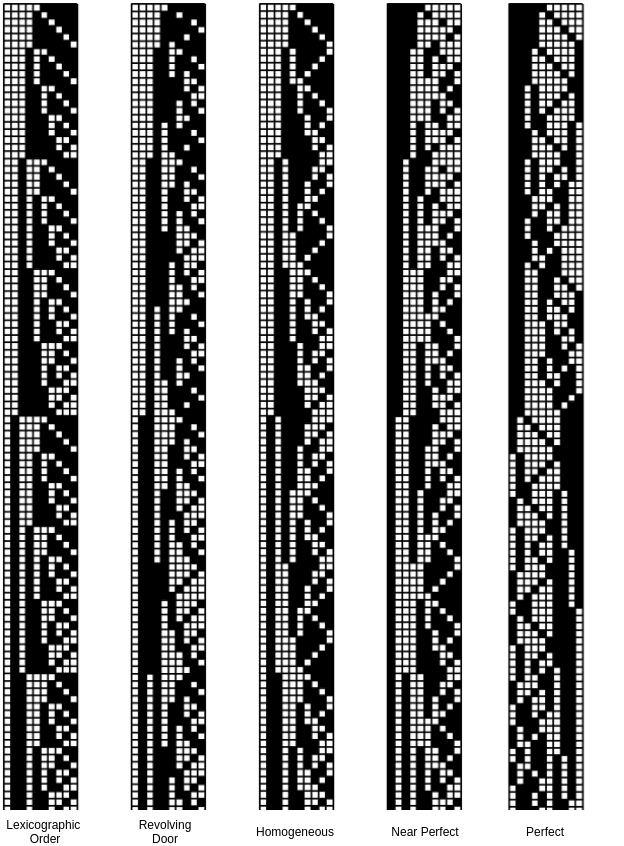
The image above was published in “The Art of Computer Programming”, volume 4A (2011).
In this article, we’ve learned about five different ways to enumerate -combinations of a set. Lexicographic order algorithm generates the subsets of size
in alphabetical order, as the name suggests. The revolving door algorithm generates
-combinations in alternating lexicographic order.
Homogeneous generation ensures that consecutive generations differ by only one element. Near-perfect schemes further ensure that the changed element moves at most two steps. Perfect schemes allow the changed element’s index to be incremented or decremented by only one.